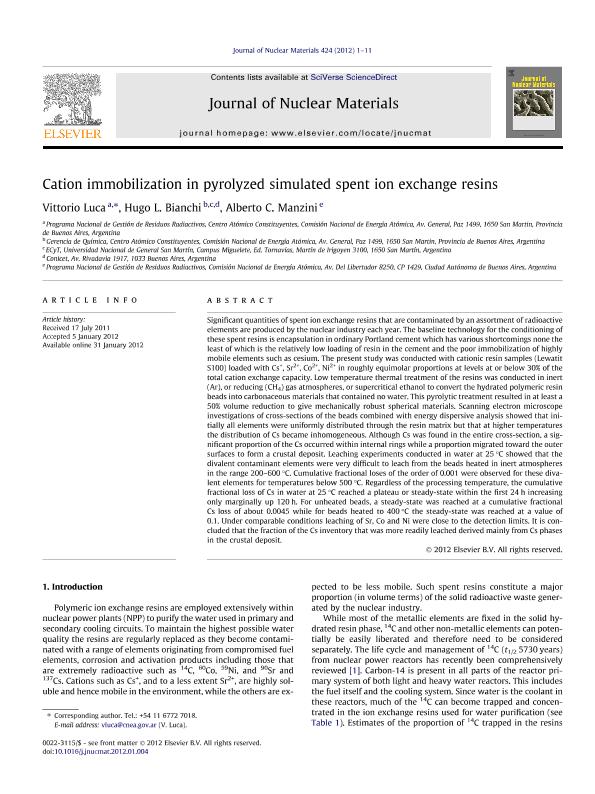Artículo
Cation immobilization in pyrolyzed simulated spent ion exchange resins
Fecha de publicación:
05/2012
Editorial:
Elsevier Science
Revista:
Journal of Nuclear Materials
ISSN:
0022-3115
Idioma:
Inglés
Tipo de recurso:
Artículo publicado
Clasificación temática:
Resumen
Significant quantities of spent ion exchange resins that are contaminated by an assortment of radioactive elements are produced by the nuclear industry each year. The baseline technology for the conditioning of these spent resins is encapsulation in ordinary Portland cement which has various shortcomings none the least of which is the relatively low loading of resin in the cement and the poor immobilization of highly mobile elements such as cesium. The present study was conducted with cationic resin samples (Lewatit S100) loaded with Cs +, Sr 2+, Co 2+, Ni 2+ in roughly equimolar proportions at levels at or below 30% of the total cation exchange capacity. Low temperature thermal treatment of the resins was conducted in inert (Ar), or reducing (CH 4) gas atmospheres, or supercritical ethanol to convert the hydrated polymeric resin beads into carbonaceous materials that contained no water. This pyrolytic treatment resulted in at least a 50% volume reduction to give mechanically robust spherical materials. Scanning electron microscope investigations of cross-sections of the beads combined with energy dispersive analysis showed that initially all elements were uniformly distributed through the resin matrix but that at higher temperatures the distribution of Cs became inhomogeneous. Although Cs was found in the entire cross-section, a significant proportion of the Cs occurred within internal rings while a proportion migrated toward the outer surfaces to form a crustal deposit. Leaching experiments conducted in water at 25°C showed that the divalent contaminant elements were very difficult to leach from the beads heated in inert atmospheres in the range 200-600°C. Cumulative fractional loses of the order of 0.001 were observed for these divalent elements for temperatures below 500°C. Regardless of the processing temperature, the cumulative fractional loss of Cs in water at 25°C reached a plateau or steady-state within the first 24 h increasing only marginally up 120 h. For unheated beads, a steady-state was reached at a cumulative fractional Cs loss of about 0.0045 while for beads heated to 400°C the steady-state was reached at a value of 0.1. Under comparable conditions leaching of Sr, Co and Ni were close to the detection limits. It is concluded that the fraction of the Cs inventory that was more readily leached derived mainly from Cs phases in the crustal deposit.
Palabras clave:
pirolisis
,
resinas de intercambio ionico
Archivos asociados
Licencia
Identificadores
Colecciones
Articulos(SEDE CENTRAL)
Articulos de SEDE CENTRAL
Articulos de SEDE CENTRAL
Citación
Luca, Vittorio; Bianchi, Hugo Luis; Manzini, Alberto C.; Cation immobilization in pyrolyzed simulated spent ion exchange resins; Elsevier Science; Journal of Nuclear Materials; 424; 1-3; 5-2012; 1-11
Compartir
Altmétricas




